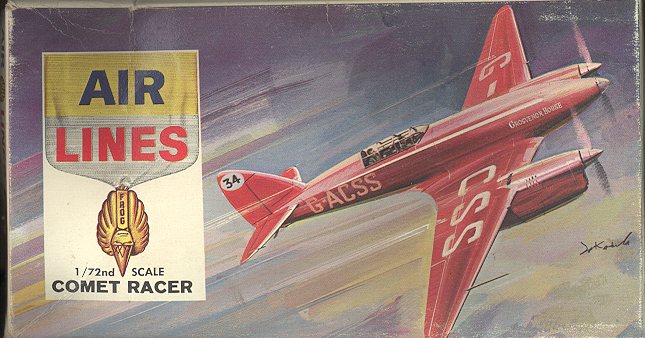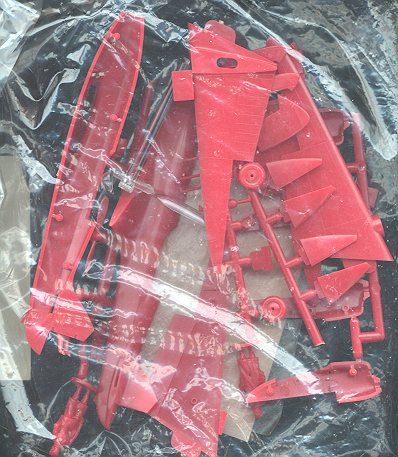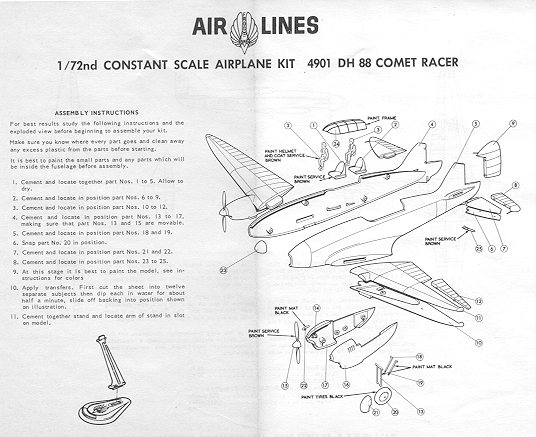
|
KIT: |
Air Lines 1/72 DH.88 Comet Racer |
|
KIT # |
4901 |
|
PRICE: |
$ |
|
DECALS: |
One aircraft |
|
REVIEW & |
|
|
NOTES: |
Kit is Frog Mold |

|
HISTORY |
Let me paraphrase from the instructions for the history of this interesting aircraft.
The year was 1933. Australian Sir Mac-Pherson Robertson offered $42,000 (a staggering sum in those depression days) as prize money for an air race from England to Australia, a 12,300 mile flight. Of the many participants, the DeHavilland DH.88 Comet was one of those that were specially built for the race.
The race started on 20 Oct, 1934 and contestants left from Mildenhall for the race. Scott and Black flew first to Baghdad but were forced to land in Turkey because of bad weather. Refueling there they headed for Singapore where they landed and found they had a large lead. The next flight was over the Timor sea to Port Darwin. While en route, they lost oil pressure in one engine and flew in on the other remaining one. Not wanting to take time to repair the bad engine, Scott and Black flew the final leg to Melbourne where they landed 70 hours and 54 minutes after leaving Mildenhall, the clear winners of the race. It was discovered there that the engine was good and the gauge had packed up!
|
THE KIT |

 There have only been two kits of this
aircraft in 1/72 scale. One by Airfix and one by Frog. Most modelers find the
Frog kit to be the best of the two. Frog kits were reboxed in the US by the
Lines Brothers and sold under the Air Lines name. They were also closely
associated with Testors so all the colors and adverts in the kit are for Testors
products. There are also two collectors cards printed on the back of the box.
There have only been two kits of this
aircraft in 1/72 scale. One by Airfix and one by Frog. Most modelers find the
Frog kit to be the best of the two. Frog kits were reboxed in the US by the
Lines Brothers and sold under the Air Lines name. They were also closely
associated with Testors so all the colors and adverts in the kit are for Testors
products. There are also two collectors cards printed on the back of the box.
Molded in red plastic so you don't have to paint it, the kit is typical of the era with a raised panel lines, minimal cockpit (but with figures) and a display stand. It also has separate control surface so that you can position them as you would like. The parts appear crisply molded and free of flash. I didn't open the bag as this is a collector's kit, you know, and still sealed with now rusty staples! The decals for the kit are of the one aircraft G-ACSS and have yellowed rather badly in the last 30 or so years.
Instructions are a bit of a joke as you can see. They basically consist of an exploded view with all the bits numbered. Any additional painting information is given next to the part. The construction steps are listed on one side of the page and are adequate to get the kit built.
Included in the box is a generic painting folder from Testors with a number of paint schemes for various kits like the Skua and Magister (though not one for the Comet). It is rather interesting reading showing happy boys playing with their new planes. The painting instructions are all for brush painting making sure that you know how to 'flow the paint off the brush to the surface of your new kit'.
In all a step back to the
youth of many.
Review kit courtesy of me and my wallet! If you would like your product reviewed fairly and quickly by a
site that has over 900 visits a day, please contact
me or see other details in the Note to
Contributors.